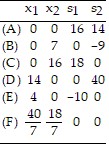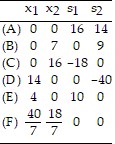Convert the given i-system to an e-system using slack variables. Then construct a table of all basic solutions of the e-system. For each basic solution, indicated whether or not it is feasible. x1 + 2x2 ? 144x1 + x2 ? 16x1, x2 ? 0
A.
| x1 + 2x2 + s1 | = 14 |

Feasible: (A), (C), (D), (F)
Not feasible: (B), (E)
B.
| x1 + 2x2 + s1 | = 14 |

Feasible: (A), (B), (E), (F)
Not feasible: (C), (D)
C.
| x1 + 2x2 + s1 | = 14 |

Feasible: (A), (B), (E), (F)
Not feasible: (C), (D)
D.
| x1 + 2x2 + s1 | ? 14 |

Feasible: (A), (B), (E)
Not feasible: (C), (D), (F)
Answer: C
Mathematics
You might also like to view...
Find the Jacobian J(u, v).

A. 14 B. -14 C. 26 D. -26
Mathematics
Evaluate the improper integral or state that it is divergent. 
A. 9 ln 
B.  ?
?
C.  ?
?
D. 
 2
2
Mathematics
If possible, factor the polynomial completely. If a polynomial cannot be factored, state that it is prime.98x2 - 32
A. 4(7x + 4)(7x - 4) B. 2(7x + 4)(7x - 4) C. 2(7x + 4)2 D. 2(7x - 4)2
Mathematics
Find the decimal approximation for the radical. Round the answer to three decimal places.
A. 3.138 B. 3.160 C. 3.170 D. 3.152
Mathematics